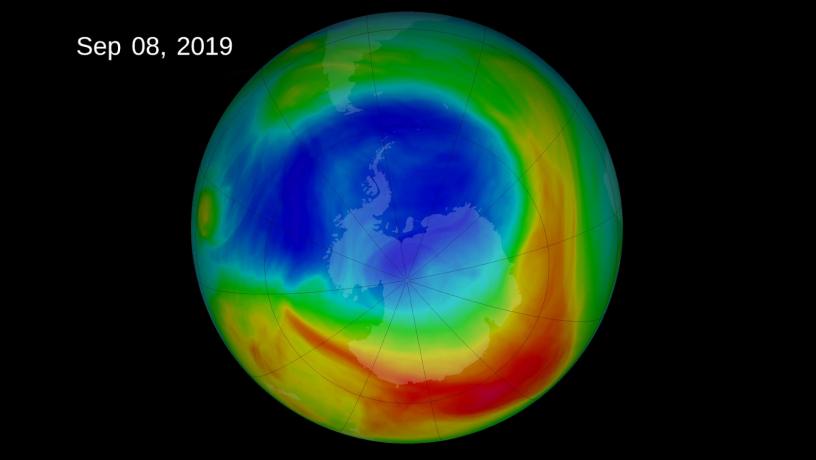Successful Ozone Treaty Stops Jet Stream Drift in the Southern Hemisphere
By phasing out the use of ozone-depleting chemicals, the Montreal Protocol has halted trends in Southern Hemisphere climate system

The 2019 ozone hole reached a peak extent of 6.3 million square miles on September 8, 2019, the lowest maximum observed in decades. This NASA visualization depicts ozone concentrations in Dobson Units, the standard measure for stratospheric ozone.

This panoramic image from February 14, 2014, shows parts of Chile and Argentina from the International Space Station (ISS). Tierra del Fuego and Cape Horn are shown here, with the Atlantic Ocean in the foreground and the Pacific Ocean across the top of the image.
More than ten years ago, Columbia Engineering climate scientist Lorenzo Polvani and his then postdoctoral fellow Seok-woo Son led a study that found, through the analysis of climate models used by the Intergovernmental Panel on Climate Change (IPCC), that the closing of the ozone hole—underway as a consequence of the 1987 Montreal Protocol—was going to halt the poleward drift of the jet stream in the Southern Hemisphere.
But Polvani’s study, published in Science in 2008, was based on predictive modeling, not actual observations. Now, new research, led by his former postdoctoral fellow Antara Banerjee, demonstrates that the earlier study’s prediction is actually happening: observations now show that, over the last 20 years, the jet stream in the Southern Hemisphere has indeed stopped drifting poleward, as the 2008 models had indicated. The new study, published March 25 by Nature, originated in Polvani’s lab and was continued by Banerjee, now a CIRES Visiting Fellow in NOAA's Chemical Sciences Division.
“The position of the jet stream has implications for many aspects of the climate system in the Southern Hemisphere: it affects the weather all the way from into the subtropics, the ocean circulation, and more,” said Polvani, Maurice Ewing and J. Lamar Worzel Professor of Geophysics in the Department of Applied Physics and Applied Mathematics and co-author of the new paper. “The pause in the jet drift is a direct consequence of the Montreal Protocol, which was signed to protect the ozone layer. This result is an excellent example that shows the climate system can be altered with international treaties, something that climate skeptics often deny. The treaty works!”
Chemicals that deplete Earth’s protective ozone layer have also been triggering changes in Southern Hemisphere atmospheric winds. Banerjee’s new study finds that those changes have paused and might even be reversing because of the Montreal Protocol, the international treaty that successfully phased out use of ozone-depleting chemicals.
“This study adds to growing evidence showing the profound effectiveness of the Montreal Protocol. Not only has the treaty spurred healing of the ozone layer, it’s also driving recent changes in Southern Hemisphere air circulation patterns,” said Banerjee.
The ozone hole, discovered in 1985, has been forming every spring in the atmosphere high over Antarctica. Ozone depletion cools the air, strengthening the winds of the polar vortex and affecting winds all the way down to the Earth’s surface. Ultimately, ozone depletion has shifted the midlatitude jet stream and the dry regions at the edge of the tropics toward the South Pole.
Previous studies have linked these circulation trends to weather changes in the Southern Hemisphere, especially rainfall over South America, East Africa, and Australia, and to changes in ocean currents and salinity.
The Montreal Protocol of 1987 phased out production of ozone-destroying substances such as chlorofluorocarbons (CFCs). Beginning around 2000, concentrations of those chemicals in the stratosphere started to decline and the ozone hole began to recover. In this study, Banerjee and her co-authors have shown that around the year 2000, the circulation of the Southern Hemisphere also stopped expanding polewards—a pause or slight reversal of the earlier trends.
“The challenge in this study was proving our hypothesis that ozone recovery is in fact driving these atmospheric circulation changes and it isn’t just a coincidence,” Banerjee said.
To do that, the researchers used a two-step statistical technique called detection and attribution: detecting whether certain patterns of observed wind changes are unlikely to be due to natural variability alone and, if so, whether the changes can be attributed to human-caused factors, such as emissions of ozone-depleting chemicals and CO2.
Using computer simulations, the researchers first determined that the observed pause in circulation trends couldn’t be explained by natural shifts in winds alone. Next, they isolated the effects of ozone and greenhouse gases separately. They showed that while rising CO2 emissions have continued expanding the near-surface circulation (including the jet stream) polewards, only the ozone changes could explain the pause in circulation trends. Prior to 2000, both ozone depletion and rising CO2 levels pushed the near-surface circulation poleward. Since 2000, CO2 has continued to push this circulation poleward, balancing the opposing effect of the ozone recovery.
“Identifying the ozone-driven pause in circulation trends in real-world observations confirms, for the first time, what the scientific ozone community has long predicted from theory,” said John Fyfe, a scientist at Environment and Climate Change Canada and one of the paper’s co-authors.
With ozone beginning to recover and CO2 levels continuing to climb, the future is less certain, including for those Southern Hemisphere regions whose weather is affected by the jet stream and those at the edge of the dry regions.
"We term this a 'pause' because the poleward circulation trends might resume, stay flat, or reverse,” Banerjee said. “It’s the tug of war between the opposing effects of ozone recovery and rising greenhouse gases that will determine future trends.”
